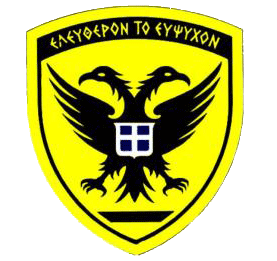Subject: History of Infantry Directorate
The infantry was established as an Arm under the first Regulation for the Organisation of the Army, which was published during the Independence War.
When the reorganization of the Army and the liberated Greek state took place under the governance of Ioannis Kapodistrias, a Tactical Corps was created, whose core was the Infantry. Since the tactical Corps was comprised of a limited force, its Commander was commanding the Infantry, and his immediate superior was the Secretary for the Military, as the Ministry of the Military was named back then.
Under King Otto's reign, when the Infantry was under the Secretariat for the Military (the article 41 of the Royal Decree of 15 April 1833 defines that “every authority, every officer and every civilian employee of the Army is subordinate to the Secretariat for the Military”), all the Secretariats were renamed as Ministries, and then the Infantry was put under the command of the Ministry for the Military.
In 1833, the Infantry included 8 Infantry Battalions and 10 Skirmishers Battalions.
In 1842, it was reorganized to include 5 Infantry Battalions and 8 Battalions of Mountain Guard.
In 1843, it was reduced to 4 Infantry Battalions and 2 Skirmisher Battalions and, in August 1854, its force was raised to 6 Infantry Battalions and 3 Skirmisher Battalions.
In 1863, for the first time, 2 Infantry Inspectors were appointed and the force of this Arm increased to 10 Battalions in total and, at the same time 10 Reserve Battalions ware established.
After Otto's abdication and King George's enthronement, an effort was launched for the reorganization of the army.
In 1864, the Infantry had 4 “Evzones” Battalions and 6 Infantry Battalions.
In 1879, the Infantry Battalions were increased to 20 and there still remained 4 “Evzones” Battalions. From 1878 on, 1 of the 8 departments which the Ministry for the Military was comprised of, was under the control of the Infantry Department. The Infantry Department was headed by a Major-rank officer assisted by a Warrant Officer.
In 27 December 1880, the Ministry for the Military was structured in 4 departments, 1 of which was the Personnel Department, which was divided in Offices. One of them was the Infantry Office whose chief was a Captain assisted by a Lieutenant. It is the first time that the Infantry is subordinate to an Office and not to a Department.
This organization of the Ministry for the Military was maintained until 1882, when it was structured again in 10 departments. One of them was the Department of the Infantry headed by a Major and staffed also by a Lieutenant, a Warrant Officer and an NCO as clerk.
This organization of the Ministry for the Military in Departments was maintained until 1912. The head of the Infantry department was a Senior Officer.
On 16 February 1912, the Ministry for the Military was restructured to include 5 directorates: personnel directorate, infantry directorate, cavalry directorate, artillery directorate and engineer directorate.
The Infantry Directorate was headed by a Colonel or a Lieutenant Colonel and staffed by 1 Major, 1 Captain and 3 clerks. For the first time, the term “Infantry Directorate” is used.
On 18 February 1926, apart from the Infantry Directorate, an Infantry Inspector was also appointed and at the rank of Major General. The inspector is responsible for the integral training of the Infantry and for the submission of the Infantry's annual training report to the Ministry for the Military.
In 1939, the Emergency Law 2005 “On the Regulation of the Army” was published, according to which the Infantry Inspection is designated as one of the general services of the Army, without the Infantry Directorate being abolished.
On 10 February 1945, under the Emergency Law of 1939, the general organization of the army includes 3 newly created Staff Directorates, as well as new Directorates. The Directorate of General Military Training is subordinate to the branch of military training. The Infantry directorate is put under the Arm special training, like the rest of the arms in the army.
Since then, the Infantry is structured by an Infantry Directorate, subordinate to the Hellenic Army General Staff and directed by a Major General. It is organized in Formations (Divisions, Brigades) Tactical Commands, Regiments, Battalions and Independent Subunits, most of which are motorized.
The Infantry Directorate comprises the Infantry School in Chalkida and the Infantry Reserve Officers School based on Heraklion, Crete.
On 06 July 2017, the Directorate was redeployed from the Hellenic Army General Staff to “Major Ioannis Velissarios” Camp, in Chalkida, where the Infantry School is also quartered, and it is located there until today.
TRAINING
The training in peace time is a paramount mission of the Infantry.
The training provided is divided into two categories: career personnel training and conscripts training.
CAREER PERSONNEL TRAINING
1.Military training:
The Infantry School, based in Chalkida, as well as the Infantry Reserve Officers School, based in Heraklion, Crete, are under the command of the Infantry Directorate.
a.Greek Schools:
The training includes subjects which are necessary for career personnel to become capable platoon commanders at war and in peace time.
(1) All the personnel of the Infantry who graduated from the Hellenic Army Academy and the NCO School, or were reenlisted or recruited as volunteers, are trained at the Infantry School on subjects of military interest, depending on the duties they will be assigned, their rank and the requirements of a modern operational environment.
(2) Candidates to become Reserve Officers are trained at the Infantry Reserve Officers School.
b.Foreign Schools:
The personnel of the Infantry, following a selection procedure, may be trained in respective schools abroad, in various military schools and universities.
2.Academic education:
The personnel, following an approval by the service, may sit entry examinations of Universities in Greece and abroad in order to obtain a postgraduate degree.
The trainees, according to the school they attend, may be granted an educational leave of absence or they perform all their service duties in parallel with their studies.
CONSCRIPTS TRAINING
Conscript soldiers, who have been selected to serve in the Infantry, are enlisted at Conscripts Reception Points across the country, they are provided with the essential military training in Units of each Formation and then they are appointed in Combat Units.


